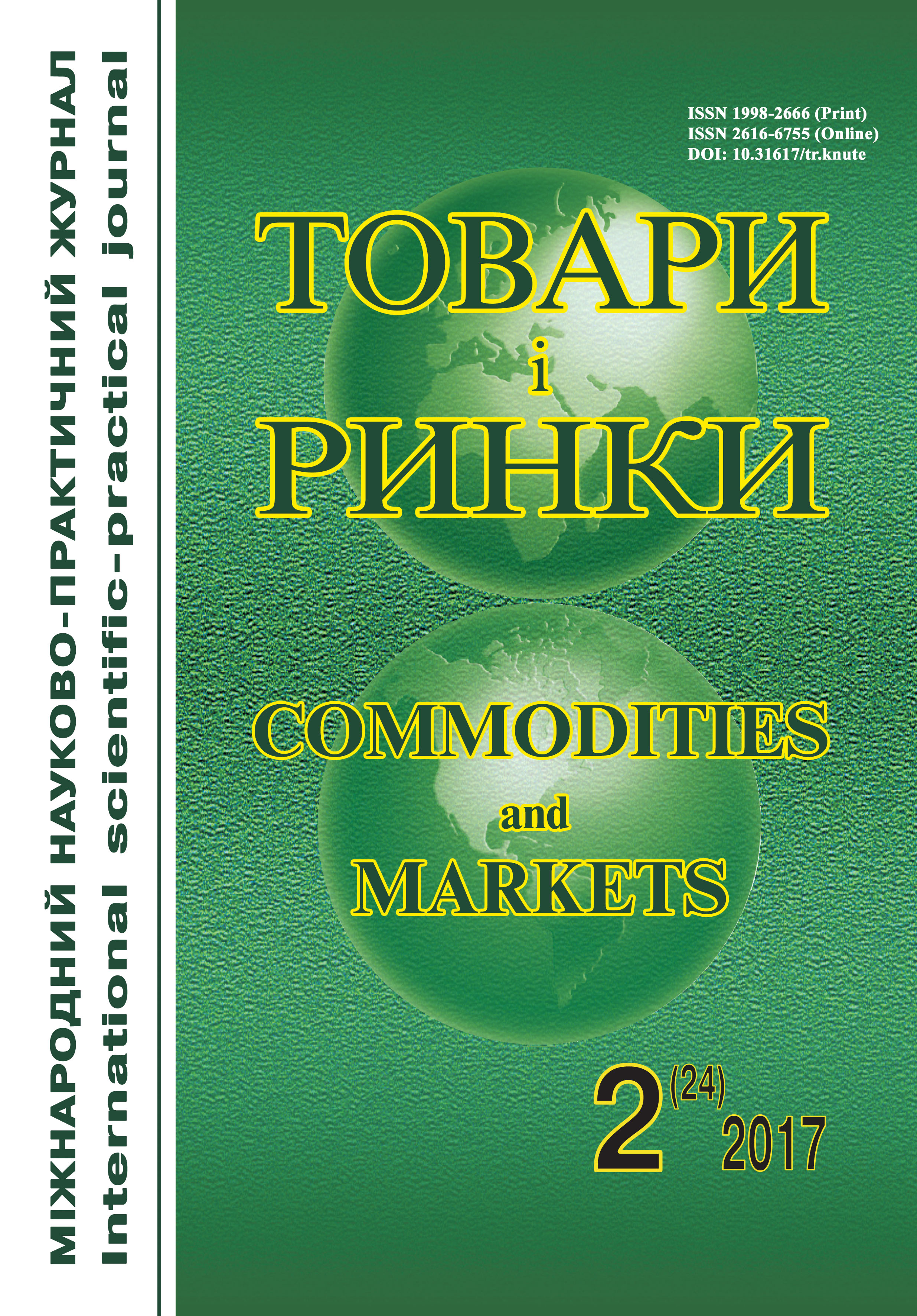Consumer properties of dogfish liver oil (Squalus acanthias)
Keywords:
fatty acid composition, dogfish, biological efficiency of lipids, fat viscosity, fat density.Abstract
Background. Ukrainian market of food products is saturated with imported fish raw material that prevents effective use of domestic hydrobionts’ reserves and this doesn’t allow to develop aquatic and mariculture. Reserves of Dogfish in Ukrainian waters are not used effectively.
It is important to elaborate a resource-saving method for obtainingoilfrom the liver of dogfish with maximum preservation of its nutritional properties for mass health nutrition.
Improving the methods for evaluating the structural and mechanical properties of edible fats allows to compare more objectively the fats’ properties of different consistency and determine the rational conditions for their storage.
The aim of this workis to determine the factors of formation and preservation of the properties of dogfish liver oil (Squalus acanthias).
Material and methods. The object of the study is the oil from the liver of dogfish (aged 15–17 years old, weighing 8.6–10.4 kg), caught in the Black Sea near the island Zmiiniy in the autumn-winter period (November – February 2015). Extraction of oil from the liver was carried out by the method of cold pressing with the addition of salt, without the use of heat treatment [11].
In order to determine rational conditions for storage one part of oil was laid in storage at a temperature of 2 ± 1 ° C (cooling – sample 1), the second batch was laid in at a temperature of –18 ± 1 °C (low-temperature storage – sample 2).
Сontainers from dark glass with capacity of 100 cm3 was selected for storage.
Sampling for research was conducted in accordance with GOST 7631-2008 [12].
In order to compare the structural and mechanical characteristics of shark oil samples of cod liver oil (sample 3) and salmon (sample 4) were purchased in a pharmacy.
The fatty acid composition of the oil from the dogfish liver was determined by the method of gas chromatography [13].
Rheological parameters such as absolute, kinetic viscosity and density of dogfish liver oil were determined using the measuring module "Rheology" with the multifunctional device "MIG-1.3" [14].
Results. The liver is 16 % of the total body weight of the dogfish and the mass fraction of oil is almost 70 % of the liver’s mass.
The received liquid fraction of oil from the Black Sea dogfish liver has such organoleptic properties: clear liquid of intense yellow color; typical taste without signs of oxidation.
It has been determined that lipids of dogfish liver contain significant amount of unsaturated fatty acids: olein (24.3 %), docosahexaenoic (13.5 %), palmitolein (8.2 %) and eicosapentaenoic (5.3 %).
The value of dynamic and kinematic viscosity for dogfish liver oil stored at low-temperature (sample 2) is within the limits of commercially obtained oils from the cod and salmon liver (samples 3 and 4).
Density index of dogfish liver oil (samples 1 and 2) is within the numerical values for fat 860–890 kg / m3, that is a sign of the quality of fats.
Conclusion. Efficiency of the use of dogfish liver oil is confirmed by the researchof mass composition: the output of the liver from individuals aged 15–17 years and weighing 8.6–10.4 kg is up to 16 %, two thirds of which is oil.
The biological efficiency of the dogfish liver oil obtained by the cold pressing method is high due to the balanced content of unsaturated fatty acids. It has been found that PUFAs in dogfish lipids are represented predominantly by the valuable docosahexaenoic, eicosalenotene and linoleic acids.
It has been proved that the structural and mechanical parameters (viscosity and density)of dogfish liver oil indicate the possibility of preserving the consumer value of the product under certain conditions.
Liver oil from the Black Sea dogfishis potentially a valuable raw material for the production of quality and safe food products in order to balance the nutritional status of the Ukrainian population.
References
Mazaraki A. A., Lebs’ka T. K., Sydorenko O. V. ta in. Innovacijni tehnologii’ pererobky ryby : monografija. Kyi’v : Kyi’v. nac. torg.-ekon. un-t, 2014. 431 s.
Rzhavskaja M. F. Zhyryy ryyb y morskyh mlekopytajushhyh. Promyyslovaja promst’, 1976. 470 s.
Lebskaja T., Grygor’eva L., Karpovec P. Osobennosty hymycheskogo sostava y perspektyvyy yspol’zovanyja dyetycheskoj dobavky "Skvamaryn". Mizhnar. nauk.-prakt. zhurn. "Tovary i rynky". 2010. № 1. S. 67—73.
Penny M. Kris-Etherton, William S. Harris, Lawrence J. Appel. Fish Consumption. Fish Oil. Omega-3 Fatty Acids and Cardiovascular Disease. Circulation. 2002. Nov. 19 (21). Р. 2747—2757. DOI: 10.1161/01.CIR.0000038493.65177.94
Spozhyvannja ryby ta ryboproduktiv v Ukrai’ni. Ekonomichnyj dyskusijnyj klub. 2017. URL : http://edclub.com.ua/analityka/spozhyvannya-ryby-ta-ryboproduktiv-vukrayini-shcho-bulo-shcho-ye-shcho-bude.
Bolila N. O., Sydorenko O. V., Korotec’kyj V. P. Biologichna efektyv-nist’ lipidiv chornomors’koi’ akuly katran : nauk. zb. "Integrovane upravlinnja vodnymy resursamy". 2014. № 2. S. 207—213.
Sajt Derzhavnoi’ sluzhby statystyky Ukrai’ny. URL : http://www.ukrstat.gov.ua.
Petrenko O. A. Otchet o nauchnoj dejatel’nosty JugNYRO za 2015 god. Kerch’. 2015. 99 s.
Jeremjejev V. M., Gajevs’ka A. V., Shul’man G. Je., Zagorodnja Ju. A. Promyslovi bioresursy Chornogo ta Azovs’kogo moriv. Sevastopol’ : EKOSI-Gidrofizyka, 2011. 367 s.
Tehnologija kompleksnoi’ pererobky gidrobiontiv. 2013. URL : http://ukrdoc.com.ua/text/16230/index-7.html.
Bolila N. O., Sydorenko O. V., Korotec’kyj V. P. Ocinka spozhyvnyh vlastyvostej chornomors’koi’ akuly katran z metoju vykorystannja v harchovij promyslovosti : zb. statej nauk.-prakt. konf. "Voda: problemy ta shljahy vyrishennja" (5—8 lyp. 2017, m. Rivne). Zhytomyr : Vyd-vo EC "Ukrekobiokon", 2017. S. 20—24.
GOST 7636–85. Ryyba, morskye mlekopytajushhye, morskye bespozvo-nochnyye y produktyy yh pererabotky. Metodyy analyza. M. : Yzd-vo standartov, 1985. 138 s.
Christie W. W. Lipid analysis. Oxford. New York : Pergamon Press,1991. 418 p.
Shapoval S. L., Romanenko R. P., Forostjana N. P. Diagnostyka fizychnyh vlastyvostej harchovyh produktiv. Kyi’v : Kyi’v. nac. torg.-ekon. un-t. 2017. 192 s.



